Welcome to the wonderful world of vinyl records! With more history than any other music format, vinyl has a fascinating story to tell. In this article, we’ll take a closer look at the production and history of vinyl. We’ll also examine how vinyl shot to the top before being left for dead, and how it’s now returning to relevancy in a digital age.
What Are Vinyl Records?
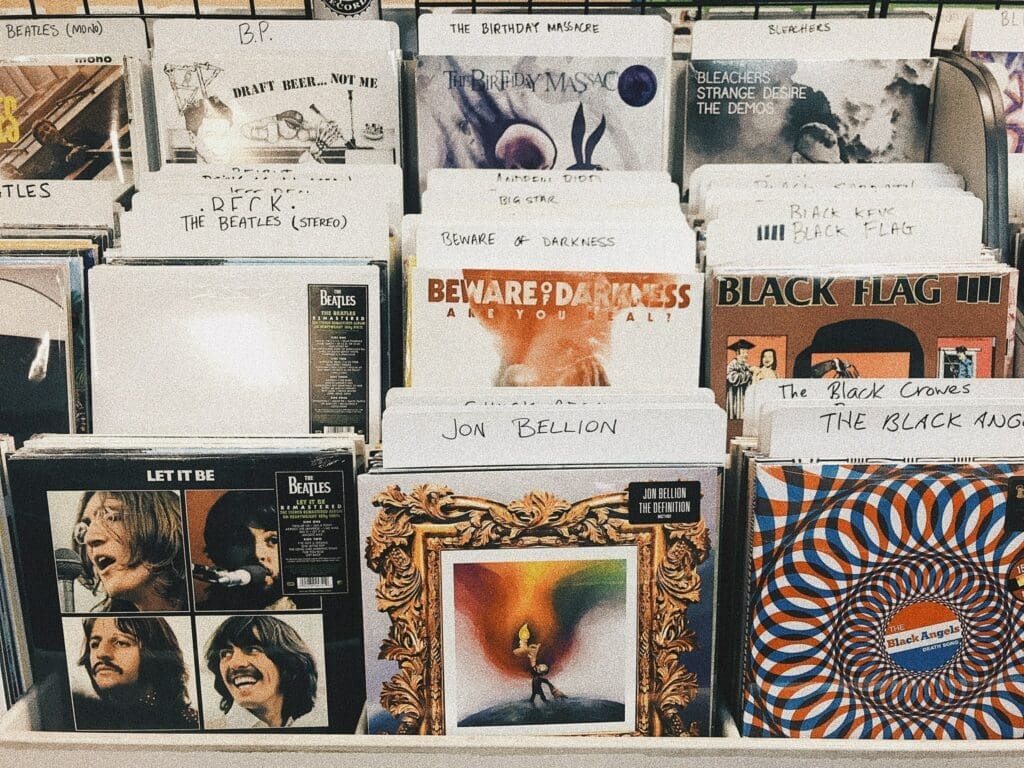
Vinyl records are an analogue audio storage medium. They’re made of a flat, disc-shaped piece of polyvinyl chloride (PVC) plastic with an inscribed, modulated spiral groove. This groove usually starts near the edge of the record and ends near its centre. A record player’s needle, called a stylus, follows the groove during playback, causing vibrations that are converted into electronic signals. These signals then travel to an amplifier, strengthening its power before sending it to speakers to convert to sound and produce noise.
Vinyl has been around since the late 1800s and was a popular format for music playback until the 1980s when its usage started to decline. Following a surge in popularity, they have become relevant again today, championed by audiophiles, collectors, and DJs, who often prefer vinyl’s warmer, richer sound over digital formats like CDs and MP3s. Vinyl records are also popular for their collectable value and nostalgic appeal.
How Are Vinyl Records Made?
After a recording has been mixed and mastered, the first step in producing a vinyl record is creating a lacquer master, an aluminium plate covered in a lacquer coating. Creating the lacquer master is like the reverse of playing a record. Rather than the stylus reading the record’s grooves, with the resulting vibrations converting into sound, a machine plays back the music, and the resulting sound converts into vibrations, causing a stylus to create grooves in the lacquer master.
The master disc is thoroughly washed and coated with silver before electroplating in nickel. The nickel fills all of the master disc’s grooves and is then separated from the master, creating a mirror image of the master with ridges rather than grooves – now we have a stamper and can start to make records!
PVC pellets are steam-heated to soften them and form a ‘biscuit’. The biscuit is then placed between two stampers (one for each side of the record) in a pressing machine, which applies tremendous force to squash the biscuit into the familiar shape of a vinyl record. After being cooled with water, our record is complete. A stamper can press 1,000 records before new ones are needed to preserve the quality of the pressing.
The Early Days of Vinyl Records
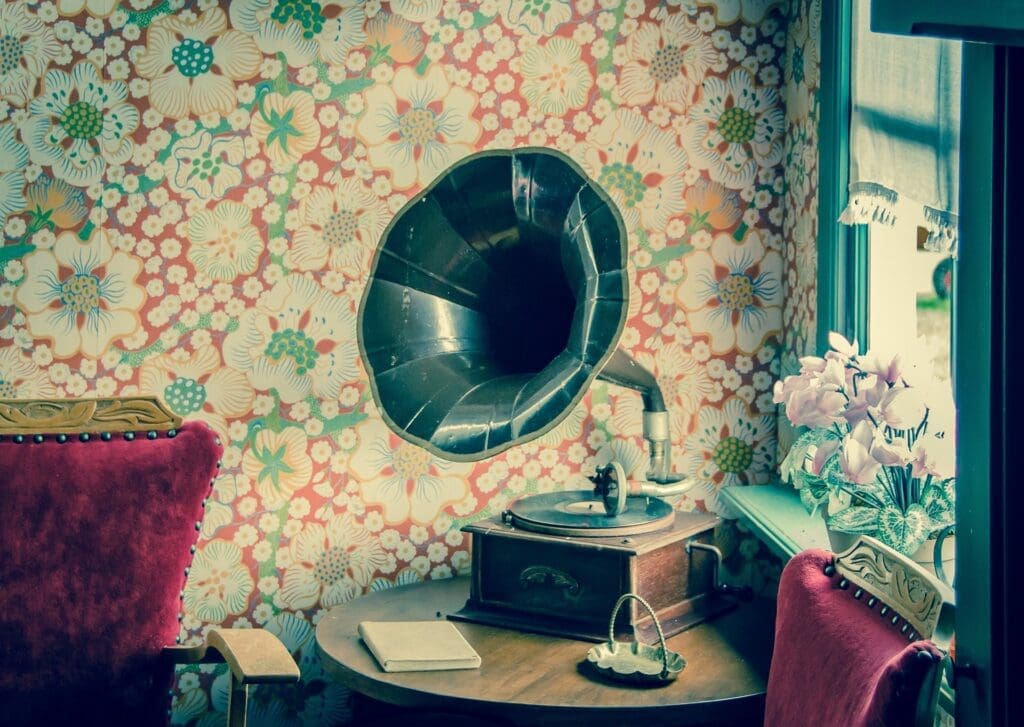
Vinyl can trace its roots back to 1857 and Edouard-Leon Scott’s phonautograph invention, which used a vibrating pen to transfer a representation of sound onto paper discs. But in 1877, Thomas Edison expanded on this invention and created the phonograph. While somewhat rudimentary compared to a modern turntable, phonographs functioned in the same fundamental way as current record players, by etching and reading rotating spiral grooves.
The technology of playing recordings continued to develop over the next few decades. Alexander Graham Bell’s Volta Laboratory created the graphophone, an improved version of the original phonograph, which reproduced sound from wax rather than metal foil. Then, in 1892, Emile Berliner presented the gramophone, which replaced cylindrical recording mediums with flat discs. From there, further refinements resulted in the creation of the more familiar record player, or turntable.
Vinyl Records in the Mid-20th Century
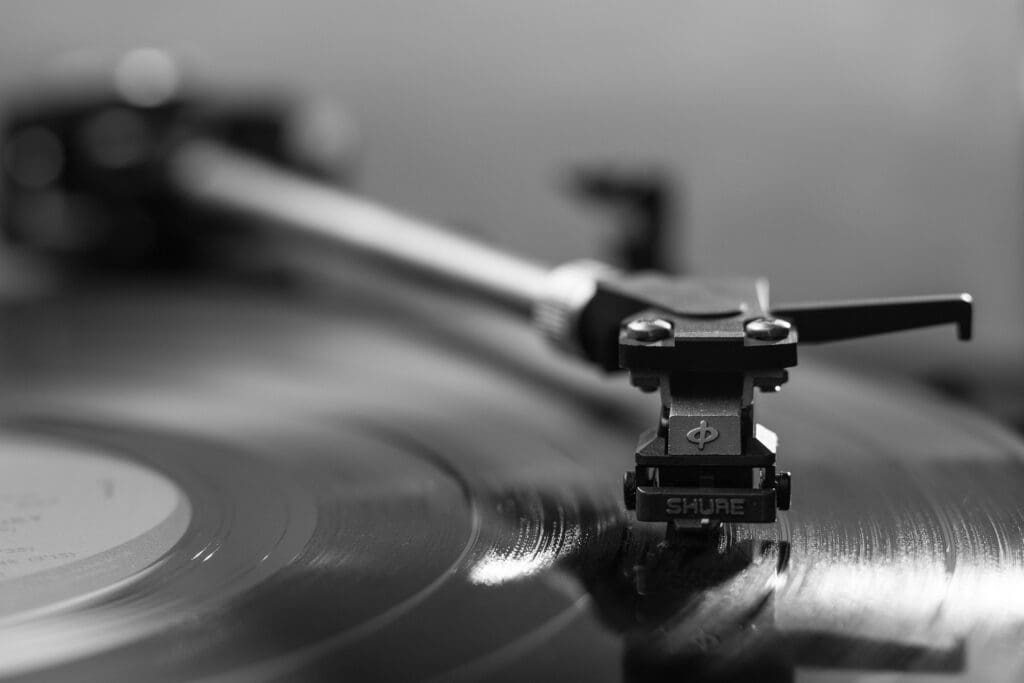
Following improvements made by RCA Victor, including the advance of 78 rpm records, Columbia Records released the first long play (LP) records in 1948, capable of storing up to 22 minutes of music per side. The first releases included recordings of Frank Sinatra and Gene Kelly, along with classical performances of compositions from Mendelssohn and Beethoven.
As LPs gradually began to overtake the sale of 78s, it became clear that the way people consumed music had changed. LPs‘ increased storage capacity allowed artists to include more songs and create a more complete body of work to present to their fans, ushering in the ‘Album Era’.
The 60s and 70s would see a surge in the popularity of nightclubs, stoked by exciting new musical genres, such as funk, soul, and disco. Vinyl records experienced a boom in popularity at this time when they were comfortably the most used format for music playback. After artists like The Beatles and Led Zeppelin released their albums on vinyl, their popularity further increased with fans of popular music. Later, the birth of hip-hop would prove to be the next catalyst for the vinyl scene.
Vinyl Records and the DJ Scene

Since the 1940s, disk jockeys, or DJs, have been synonymous with the story of vinyl records. Building on the turn-of-the-century advent of radio DJs, the 1940s and 50s saw the rise of early European discotheques, such as the Whiskey à Go-Go in Paris, and sock hop parties in the U.S, where DJs would play pop music records for the enjoyment of those on the dance floor. But it was in Kingston, Jamaica, where the DJ scene would begin to resemble modern iterations more closely. The development of sound systems saw DJs team up with MCs to spin records that they would play back through increasingly large and complex PA speaker systems.
Scratching and Turntablism
The art of turntablism arguably began in New York in 1974, when DJ Kool Herc, known as ‘The father of hip-hop’, would mix between two duplicate records during block party DJ sets to create extended rhythm sections. A year later, DJ Grand Wizard Theodore would accidentally invent scratching – the art of physically manipulating a vinyl record during playback on a turntable to create percussive sounds and rhythms. These two elements combined perfectly with the fast-developing hip-hop culture movement, which took its cues from Jamaican dub music, rapping inspired by sound system-style MCs, and older American music genres like blues, funk, and soul.
As hip-hop grew beyond being more than just a music genre, incorporating street art, clothing, and dance styles, so did its popularity. This new-found cultural buzz further brought vinyl records to the public’s attention.
The Importance of Vinyl Records for Underground Raves
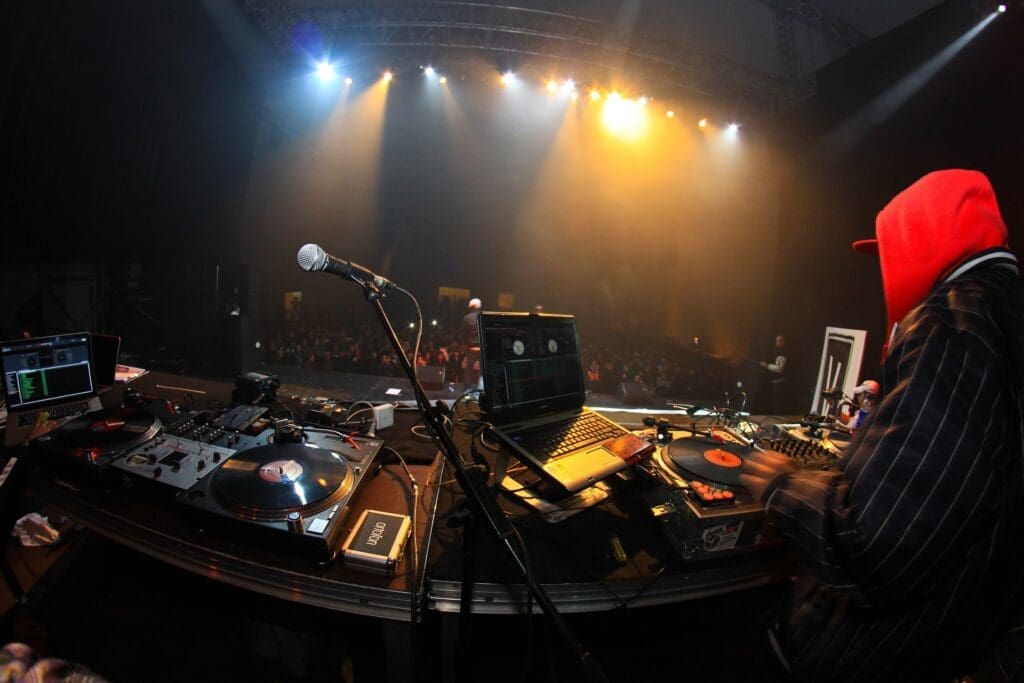
Alongside the birth of hip-hop, various dance music genres started to emerge from locations around the world. This included house music from Chicago, techno from Detroit, Belgian new beat, and synth-pop from Japan, West Germany, and the U.K. These styles would themselves go on to inspire a host of new sounds, such as breakbeat, hardcore, and jungle, which all helped to develop the fledgling underground rave culture.
While all these genres relied heavily on vinyl records, jungle, in particular, formed a special attachment with vinyl records. Taking equal inspiration from the burgeoning dance music scene and the imitable Jamaican dub, dancehall, and sound system movements, jungle had vinyl grafted into its DNA from day one. But while jungle helped to keep it alive, the onset of new mediums meant that maintaining vinyl’s dominance would prove to be too much of a challenge.
The Fall of Vinyl
Despite booms in overall music sales caused by exciting new genres in the 80s, vinyl’s market share began a steady decline that would continue for nearly 30 years. The causes for this decline were primarily new playback formats and how listeners consumed music.
Vinyl vs Tapes
After the invention of the compact cassette in the 1960s, the format gradually became more popular over the next two decades. A more mobile and straightforward medium, cassettes offered music companies new potential sales avenues, such as car stereos and portable devices like the Sony Walkman. Ultimately, cassettes would overtake vinyl record sales by the mid-80s.
Vinyl vs CDs
Compact discs (CDs) were launched in Japan in 1982, spreading worldwide over the next 12 months. CDs quickly made a dent in both vinyl and cassette sales by offering more storage capacity, better mobility, and technically superior digital sound quality. Despite the best efforts of vinyl-loving specialist genres and audiophiles, the world latched on to CDs, making them the standard audio format for the next 20 years. CD sales peaked at the turn of the millennium – in 1999 and 2000, U.S. CDs reached over $13 billion in annual sales.
Vinyl vs Streaming
Despite the massive success of CDs, their heyday would quickly start to end after peaking in 2000, when the world welcomed new digital formats. Illegal file-sharing sites, such as Kazaa and the infamous Napster, caused music sales in all forms to plummet, creating panic amongst record company execs.
After early iterations of music streaming through sites such as MySpace and YouTube, 2008 saw the introduction of Spotify. Its premise was quickly apparent – a legal alternative to file-sharing sites, offering the same easy and cheap access to music through a monetised service that provided due royalties to artists. After seeing Spotify’s obvious appeal to the modern consumer, competitor services didn’t take long to spring up, including Deezer, Tidal, Amazon Music, and Beats Music, which would later become Apple Music.
Within a few short years, streaming would start to replace radio airplay as a measure of success. By 2014, album-equivalent units, a measurement of music consumption equal to a purchased album copy, would be included in music charts in various countries.
However, the boom in streaming services appeared to have one unexpected result. While streaming had started dismantling CD sales, the first few years of streaming’s rise to the top also saw the start of an upturn in vinyl sales.
The Vinyl Revival
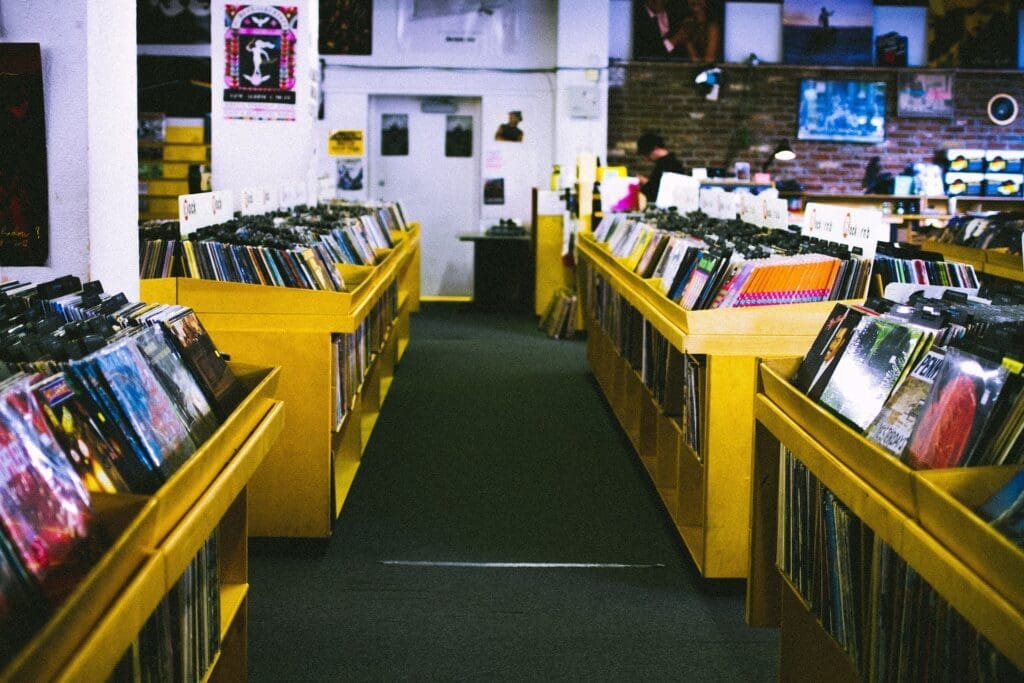
Following the dominance of streaming, CDs and cassettes were no longer the most mobile or accessible method of consuming music, leading them almost to lose their market share entirely. Vinyl, however, was something different. It didn’t rely on being a quick fix for enjoying music. With its warm and imperfect analogue offerings, it was more of an experience. And in the face of the dominance of cold, digital streaming, vinyl gave consumers an option that CDs and cassettes didn’t. It’s been a slow road, but the last 15 years have seen a gradual increase in vinyl sales that few could have predicted at the turn of the millennium.
Vinyl Specialists
At vinyl’s lowest ebb, some still saw its value – the vinyl specialists. With interest at an all-time low, there had never been a better time to pick up rare and sought-after records, often at a discount. This activity and the support of genres like drum and bass, which stubbornly stuck with vinyl in the face of adversity, meant that vinyl never truly died but hibernated through a winter of CDs and digital downloads.
The Resurgence of Records
Since 2008, vinyl sales have increased almost every year. It’s still far behind streaming as a percentage of music sales (2022 saw streaming account for over 84% of music sales in the U.S.). But vinyl has firmly claimed the number two spot, surpassing CD sales in 2022 and becoming the biggest-selling physical music format for the first time since 1987.
While it might be easy to assume that older generations are driving vinyl sales, the inverse is true – Gen Z listeners are reportedly 27% more likely to buy a vinyl record than the average music listener, meaning that the future could be bright for vinyl.
Buying Vinyl Records

Despite not being bought at anything like the quantities seen at its peak, there have never been more options for buying vinyl records than there are today. Alongside brick-and-mortar record stores, there are many online-only retailers and services, such as Discogs, an online marketplace for buying and selling music.
Benefits of Shopping at a Vinyl Record Store
Although it’s certainly easy to buy records online, there are definite benefits to shopping in a physical record store:
- Personalised Service: Shopping at a vinyl record store allows you to receive personalised service from knowledgeable staff members who can help you find the perfect record for your collection.
- Try Before You Buy: Shopping at a record store can give you the opportunity to hear the music and check your copy for defects before you buy it.
- Support Local Business: Shopping at a local record store helps support your local economy and keeps your money in the community.
- Discover New Music: Visiting a record store allows you to discover new music you may not have heard of before. By searching through rows of records or asking for the opinion of shop staff, you might find your new favourite band!
- Build Community: Shopping at a record store allows you to connect with other music lovers and build relationships with people who share your passion for music.
Vinyl Pressing With Music Gateway
Music Gateway has expanded its services to provide comprehensive vinyl pressing not only in the UK but also across Europe, USA, Canada and more. The newly introduced high-end vinyl pressing service includes a variety of 12″ records and albums available in different colours and unique effects such as colour-in-colour, marble, and splatter. The service requires a minimum order of 100 units and guarantees swift delivery times along with top-notch quality.
Pre-release Vinyl Pressing is perfect if you’re looking to finance your forthcoming release without any immediate costs. This method allows you to fund your vinyl production through pre-release campaigns, requiring a minimum order of just 100 copies. It also gives you enough time to gather funds from fans before the vinyl’s manufacturing process begins.
Regardless of whether it’s a single, album, EP or any other recording project, both the production and distribution aspects are handled for you. Your vinyl will be shipped directly to your fans, reducing shipping charges and environmental impact.
Top Ten Records Stores in London

Whether you’re a seasoned collector or just starting out, there’s no better way to experience music than on a classic record. But with so many record stores out there, it can be challenging to know which ones are the best. That’s why we’ve compiled this guide to London’s best vinyl record stores!
Icons of Underground
Unfortunately, some genuinely iconic stores are no longer with us, such as Soho’s legendary Black Market Records, which championed underground dance music for over 30 years. Still, the resurgence in vinyl has seen new favourites emerge, and some old stalwarts grow from strength to strength. We’ll look at each store’s record selection and atmosphere to help you find the perfect place to pick up your next favourite record. So, let’s get started!
· Rough Trade: Since opening in 1976, Rough Trade has grown into one of the most iconic record stores in the world. Now with various locations across the city, it carries a wide selection of new and used vinyl records, CDs, DVDs, and other music-related merchandise. It also has a great selection of rare and hard-to-find records, while its East London store has a stage for hosting gigs.
· Crypt of the Wizard: If you like your music on the darker side, then Hackney’s Crypt of the Wizard is the place for you. Specialising in just about every possible subgenre of underground metal, the store is arguably London’s number one choice for new and used heavy metal vinyl records and cassettes.
Legends of Vinyl
· Lion Vibes: If reggae is your game, then you will want to venture into Brixton for a visit to Lion Vibes. One of the world’s oldest reggae record stores, it’s vinyl-only and stocks the best in new and used reggae vinyl records.
· Reckless Records: Nestled in the heart of Soho, Reckless Records has operated since 1984. Specialising exclusively in used vinyl and CDs, Reckless constantly adds to their stock by buying collections from those looking to sell, so you never know what you might find during your visit.
· Out on the Floor Records: Given its location in the heart of Camden Town, it’s no surprise that Out on the Floor specialises in alternative genres. But while fans of rock, metal, prog, and punk will no doubt be happy, the store also has offerings for those who prefer soul, funk, jazz, folk, and reggae. Indeed, aside from an outstanding stock of new and used vinyl records, the store also has its own reggae record label, Tuff Scout.
· Phonica: Phonica is one of London’s finest dance and electronic music record vendors. With a great selection of vinyl and CDs, you can pick up everything from dubstep and nu-disco to krautrock and nu-jazz.
Old School Greats
· Rise Above Records and Relics: Founded as a record label in 1988 by Lee Dorian, frontman of legendary British doom metallers Cathedral, Rise Above has since opened a brick-and-mortar store in Highgate. As fans of Dorian’s work might expect, the store is the place to be for all things doom, stoner, psychedelic, and experimental, with a smattering of reggae, funk, punk, and jazz thrown in for good measure.
· Honest Jon’s: First opening in 1972, Honest Jon’s in Ladbroke Grove is one of the world’s most renowned record shops. Eschewing much of the mainstream, the store stocks rarer sounds and the best of the underground, along with running its own record label.
· Sounds of the Universe: The home of Soul Jazz Records, Soho’s Sounds of the Universe hosts one of the U.K.’s most extensive collections of reggae, dubstep, house, disco, funk and soul, and world beats. With LPs, CDs, 45s, and books all on offer, Sounds of the Universe is an eclectic store with a constantly updating selection of goodies.
· Stranger than Paradise: Situated in a converted Hackney warehouse, Stranger than Paradise was founded by an ex-employee of Rough Trade East. The store specialises in indie music and British jazz, but on any given visit, you’ll find a great range of rock, world music, metal, bass, reggae, folk, and everything in between.
Ten Most Expensive Vinyl Records of all Time
While new vinyl prices have fluctuated over the years, limited run and out-of-print pressings have seen the cost of some specific albums grow to eye-watering amounts. Here’s our list of the top ten most expensive vinyl records of all time:
10. Scaramanga Silk, Choose Your Weapon – $41,095
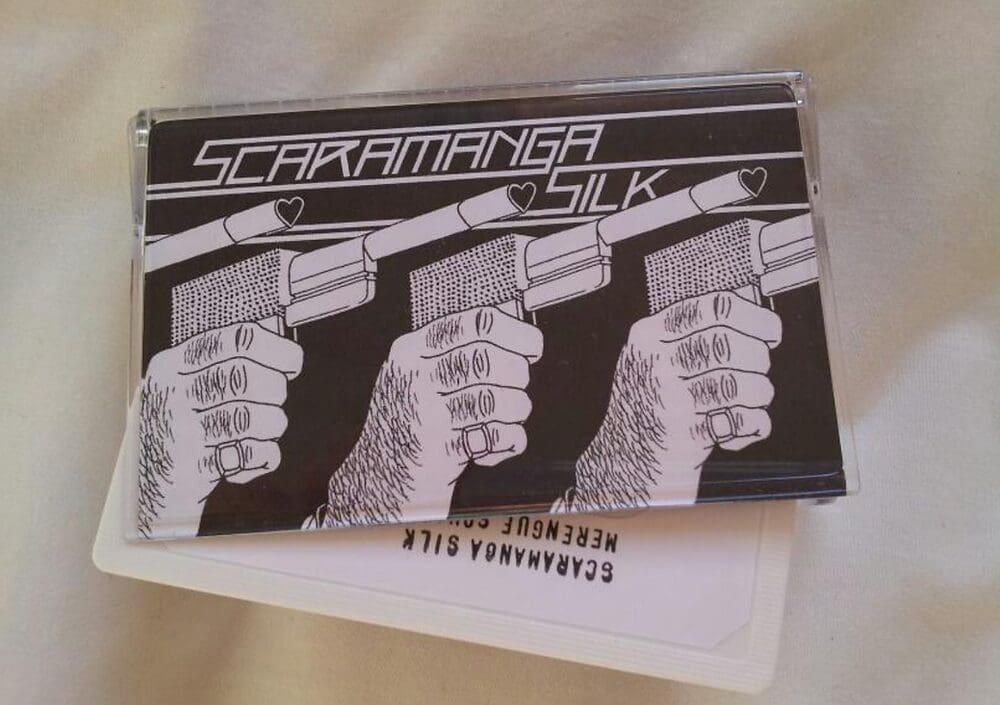
British breakbeat DJ Scaramanga Silk self-released just 20 copies of his single, Choose Your Weapon, in 2008. In 2021, a copy sold on Discogs for $41,095, or approximately £30,000.
9. Aphex Twin, Caustic Window (test pressing) – $46,300

A relatively recent addition to this list, 2014 saw the release of ‘Caustic Window’ by Richard David James, otherwise known as experimental electronic artist Aphex Twin. While there was nothing unusual about the price of the actual release, a vinyl test pressing sold at auction for $46,300 (around £36,000) and was bought by Minecraft creator Markus ‘Notch’ Persson.
8. The Beatles, Till There Was You – £77,500
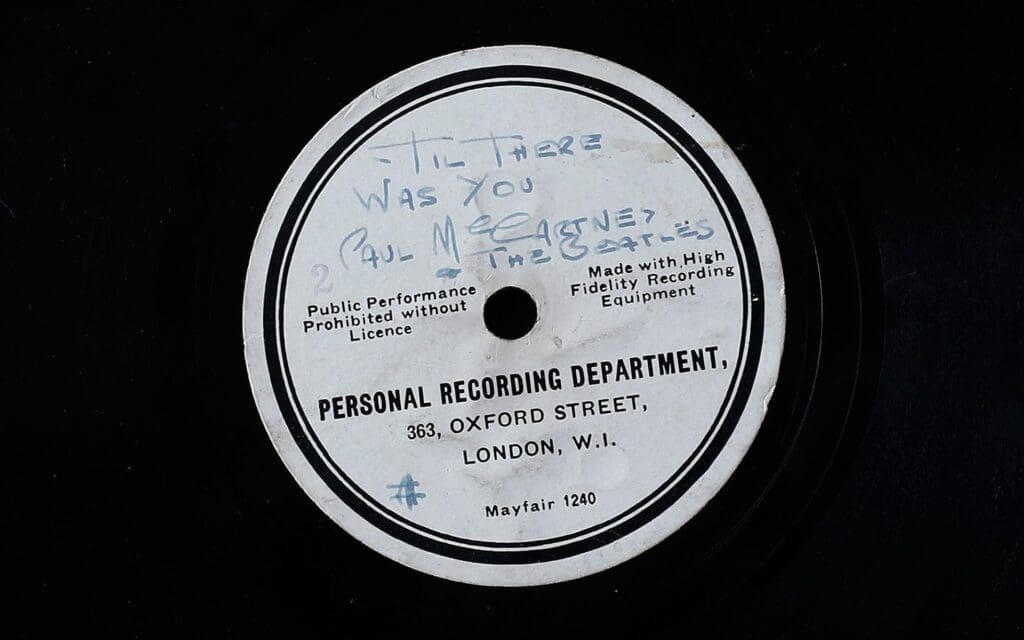
The first of multiple Beatles-related entries on this list! A scarce 10″ acetate copy of the group’s early demo was found by Les Maguire, keyboardist for Gerry and The Pacemakers, in his attic. It sold at auction in 2016 for £77,500.
7. The Beatles, Yesterday & Today – $125,000
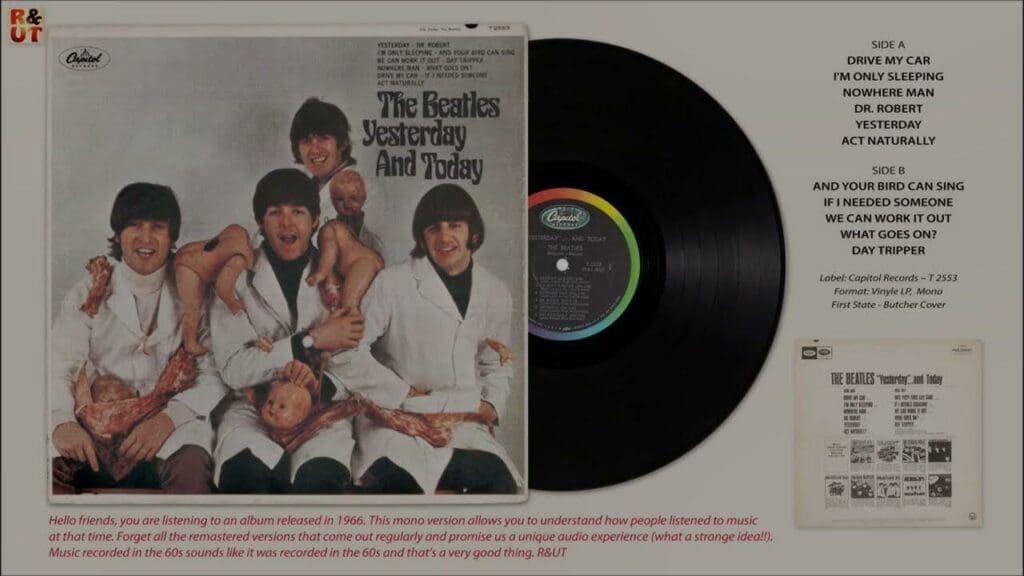
This 1966 compilation initially only saw a North American release. While it later had a Japan release, it never made its way to Europe or the U.K. The record was made available with two different album artworks, the first of which was quickly withdrawn, making it particularly rare. Indeed, a mint, still sealed copy sold in 2013 for $125,000 (about £98,000).
6. Frank Wilson, Do I Love You (Indeed I Do) – £100,000
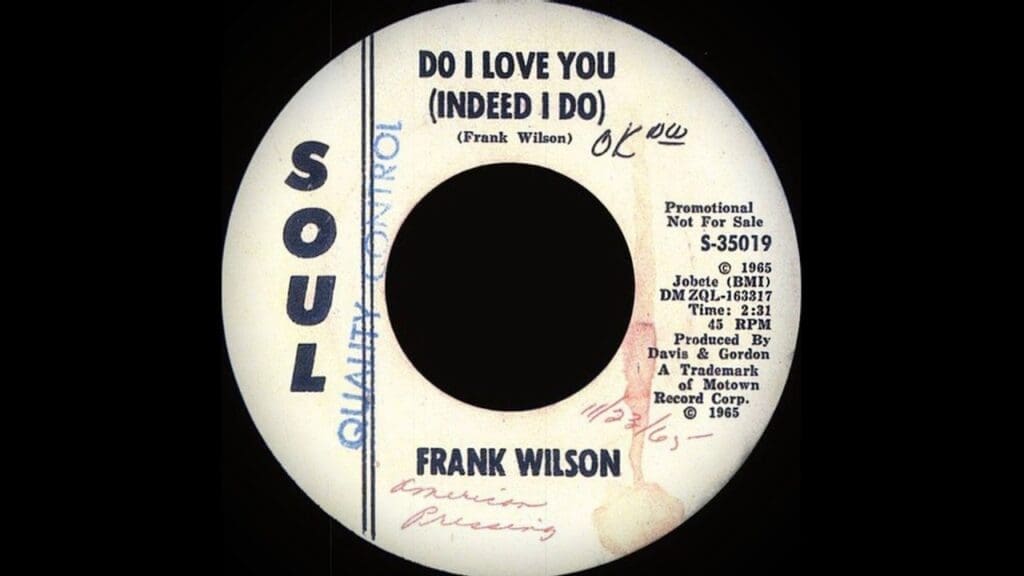
The American soul singer’s 1965 single saw a limited release of 250 45s, most of which were destroyed in mysterious circumstances. Most experts believe that only between two and five copies survived, one of which sold in 2009 for £25,742. But in 2020, when this exact same copy returned to sale, Lee Jefferies from Market Harborough bought it for around £100,000.
5. John Lennon & Yoko Ono, Double Fantasy – $150,000
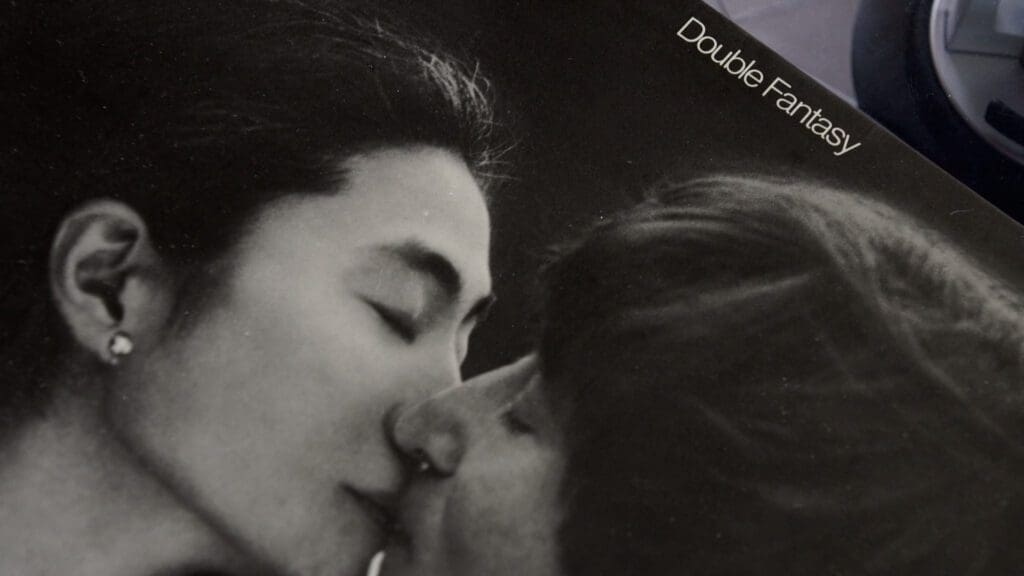
While this record is widely available and not normally too financially valuable, one copy can claim a unique and tragic circumstance that significantly boosted its value. Selling at auction in 1999, John Lennon signed the copy in question just hours before his tragic murder in 1980. The attraction of potentially the last album ever sold by Lennon meant that this copy sold for $150,000, or around £118,000.
4. The Beatles, Sgt. Pepper’s Lonely Hearts Club Band – $290,000
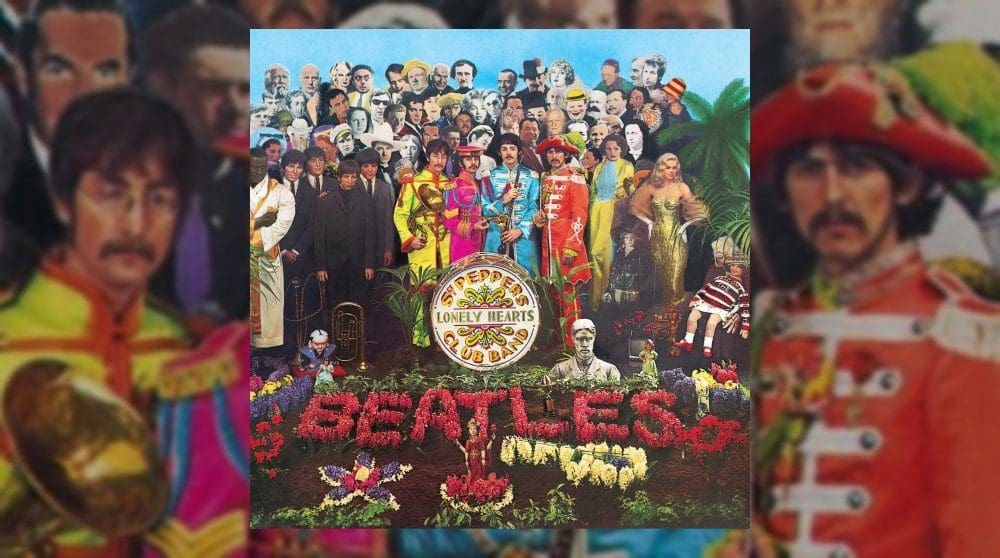
Original pressings of this 1967 release can already fetch a pretty penny. But in 2013, a copy signed by all four Beatles sold for a massive $290,000 (around £227,000), smashing the auction house’s estimated selling price of $30,000.
3. Elvis Presley, My Happiness (test pressing) – $300,000
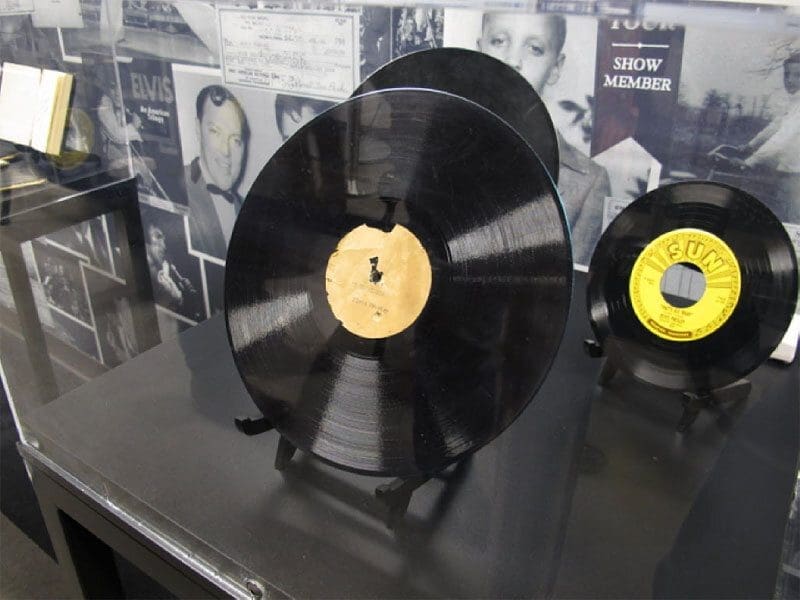
Another album that in itself isn’t particularly rare, in 2015, a test pressing of the single release sold for $300,000, or about £240,000. The buyer? None other than Jack White of The White Stripes. White bought the rare disc to rerelease it via his own Third Man Records.
2. The Beatles, The Beatles (the White Album) – $790,000

It was no secret that Beatles drummer Ringo Starr owned the first copy of the band’s iconic 1968 self-titled album, but in 2015 Starr sold the album at auction to an unnamed buyer, fetching a whopping $790,000 (about £620,000).
1. Wu-Tang Clan, Once Upon a Time in Shaolin – $4,000,000

Wu-Tang Clan’s 2015 album is something of a unique release and undoubtedly one of the rarest in existence – because they only ever printed one copy! It was bought by Martin Shkreli, the notorious CEO of Turing Pharmaceuticals, for $2,000,000, or about £1,500,000. Unfortunately for Shkreli, following his imprisonment for securities fraud, authorities seized the record along with his other assets and sold to PleasrDAO, an NFT-purchasing company, for a staggering $4,000,000!
The Future of Vinyl Records
With streaming now the most dominant form of consuming music, vinyl is unlikely to ever return to its glory days and again become the medium of choice. But it’s clear that, even in an increasingly digital world, there’s still a place for those not-so-little PVC discs and their perfectly imperfect analogue audio.










